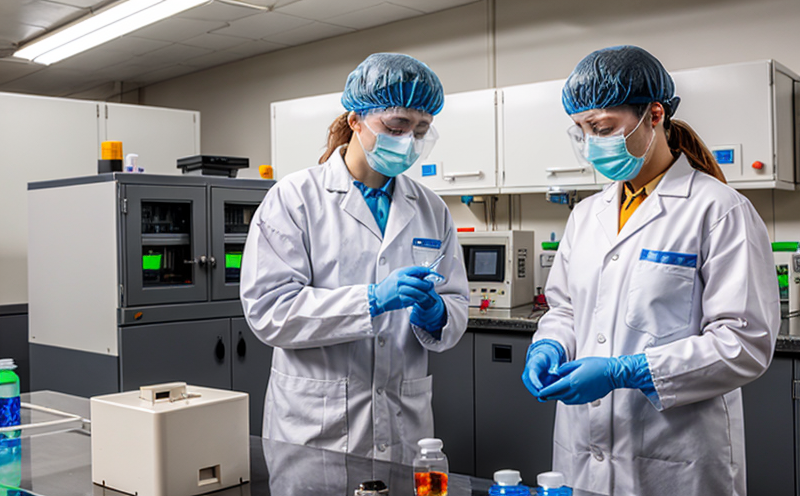EN 16655 Acrylamide Profiling in Baked Goods
The European Standard EN 16655:2017 provides a method to determine acrylamide levels in processed food products, particularly focusing on baked goods. This standard is crucial for ensuring the safety and quality of food items consumed by the public. Acrylamide forms during high-temperature cooking processes when certain carbohydrates react with asparagine, leading to potentially harmful compounds. Baked goods such as breads, pastries, and crackers are common culprits due to their frequent exposure to high temperatures.
Implementing EN 16655 helps food processors maintain compliance with regulatory requirements set by various authorities worldwide. By profiling acrylamide levels in baked goods, manufacturers can identify potential risks early on and implement corrective measures to minimize the formation of this compound. This not only safeguards consumer health but also enhances brand reputation.
The testing process involves several steps that are critical for accurate results. Specimens must be prepared carefully according to specified protocols outlined in EN 16655. These procedures ensure that any acrylamide present is accurately quantified without interference from other compounds. After preparation, samples undergo extraction using solvent-based methods followed by derivatization if necessary before analysis via gas chromatography-mass spectrometry (GC-MS).
Instrumentation plays a key role in this testing procedure. Advanced GC-MS systems equipped with selective ion monitoring (SIM) capabilities are used to detect acrylamide at trace levels. These instruments provide precise quantitative data which is essential for understanding the extent of contamination and guiding mitigation strategies.
Reporting results based on EN 16655 requires adherence to specific guidelines that emphasize transparency and clarity. The report should include details about sample preparation, instrumental conditions, observed peak areas corresponding to acrylamide, and calculated concentrations expressed in parts per billion (ppb). Additionally, comparisons with established limits provided by relevant standards like Codex Alimentarius can help stakeholders assess compliance status.
In summary, EN 16655 offers a robust framework for profiling acrylamide levels in baked goods. Its application ensures that food products meet stringent safety criteria while contributing to overall public health protection. Employing this standard allows companies to stay ahead of regulatory trends and demonstrate their commitment to producing safe, high-quality food items.
Why It Matters
The presence of acrylamide in food products has been linked to various adverse health effects including cancer risks. As a result, there is growing concern among consumers about the safety of their diet and increasing pressure on manufacturers to reduce these contaminants. By adopting EN 16655, businesses can address these concerns head-on by conducting thorough analyses aimed at identifying and managing acrylamide levels in baked goods.
Adherence to this standard also provides an opportunity for companies to differentiate themselves from competitors who may not prioritize such rigorous testing protocols. Demonstrating leadership through proactive measures like compliance with EN 16655 can significantly enhance a company’s market standing and consumer trust.
Furthermore, meeting the requirements stipulated by EN 16655 can facilitate smoother interactions with regulatory bodies and international markets where strict regulations govern food safety. This could open up new business opportunities both domestically and abroad as companies gain credibility through consistent adherence to recognized standards.
Ultimately, implementing EN 16655 is not just about meeting legal obligations; it’s also about fostering a culture of responsibility towards public health and environmental sustainability within the industry.
International Acceptance and Recognition
The European Standard EN 16655:2017 has gained widespread acceptance beyond its geographical boundaries. Countries across Europe, North America, Asia, and Oceania have adopted this standard as part of their regulatory frameworks for food safety. Its international recognition stems from the rigorous scientific basis behind it and the comprehensive approach towards addressing acrylamide contamination.
Several countries including Canada, Australia, New Zealand, and parts of Latin America have incorporated EN 16655 into their national standards or guidelines. This harmonization across borders ensures consistency in testing methodologies and interpretation of results, thereby facilitating easier trade between nations while maintaining high safety standards.
The international acceptance of EN 16655 reflects the global commitment to reducing acrylamide levels in food products. By aligning with this standard, countries demonstrate their dedication to protecting public health and promoting responsible manufacturing practices. This alignment fosters trust among consumers who can rely on consistent quality across different markets.
Moreover, compliance with EN 16655 enables businesses operating globally to meet multiple regulatory requirements simultaneously without the need for separate testing processes in each country. This streamlined approach enhances operational efficiency and reduces costs associated with differing standards.
Competitive Advantage and Market Impact
Complying with EN 16655 offers significant competitive advantages that can positively impact a company's market position. In today’s highly competitive food industry, maintaining high safety standards is crucial for gaining and retaining consumer trust. By profiling acrylamide levels in baked goods using this standard, manufacturers demonstrate their commitment to producing safe and quality products.
Consumers are increasingly becoming aware of the risks associated with acrylamide intake and seek out brands that take proactive steps to minimize these contaminants. Companies that adopt EN 16655 can position themselves as leaders in food safety, thereby attracting a loyal customer base that values health-conscious choices.
The ability to consistently meet or exceed regulatory requirements also enhances brand reputation and credibility. This positive image can translate into increased sales volumes as consumers are more likely to choose products from reputable sources. Additionally, compliance with international standards like EN 16655 opens up new markets for companies looking to expand their reach globally.
Furthermore, adopting this standard allows businesses to stay ahead of potential regulatory changes and emerging trends in food safety. By being proactive in implementing rigorous testing protocols now, companies position themselves to easily adapt to future requirements without significant disruption to operations.
In conclusion, complying with EN 16655 provides a competitive edge that extends beyond immediate market benefits. It fosters long-term growth by building lasting relationships with consumers and paving the way for successful expansion into international markets.





